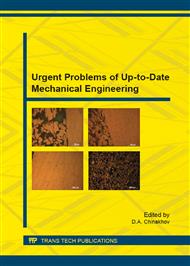[1]
O.M. Alifanov, E.A. Artyukhin, S.V. Rumyantsev, Extremal solutions of ill-posed problems and their applications to inverse heat transfer problems, Nauka, Moscow, (1988).
Google Scholar
[2]
A.A. Samarskii, P.N. Vabishevich, Numerical methods for inverse problems in mathematical physics, Editorial URSS, Moscow, (2004).
Google Scholar
[3]
G.V. Alekseev, D.A. Tereshko, Analysis and optimization in viscous fluid hydrodynamics, Dal'nauka, Vladivostok, (2008).
Google Scholar
[4]
G.V. Alekseev, Solvability of stationary boundary control problems for thermal convection equations, J. Sib. Mat. Zh. 39 (1998) 982–998.
DOI: 10.1007/bf02672906
Google Scholar
[5]
G.V. Alekseev, Stationary problems of boundary control for heat convection equations. J. Dokl. Math. 58 (1998) 314–317.
Google Scholar
[6]
G.V. Alekseev, D.A. Tereshko, On solvability of inverse extremal problem for stationary equations of viscous heat conducting fluid. J. Journal of Inverse and Ill-Posed Problems. 6 (1998) 521-562.
DOI: 10.1515/jiip.1998.6.6.521
Google Scholar
[7]
G.V. Alekseev, D.A. Tereshko, The stationary optimal control problems for the viscous fluid equations. J. Sib. J. Indust. Math. 1 (1998) 22–44.
Google Scholar
[8]
G.V. Alekseev, Inverse extremal problems for stationary equations in mass transfer theory. Comput. J. Math. and Math. Phys. 42 (2002) 363–376.
Google Scholar
[9]
H.C. Lee, Analysis and computational methods of Dirichlet boundary optimal control problems for 2D Boussinesq equations, J. Advan. Comput. Math. 19 (2003) 255–275.
Google Scholar
[10]
G.V. Alekseev, Inverse extremum problems for stationary heat convection equations, J. Vestn. Novosibirsk. Univ. Ser. Mat. 6 (2006) 7–31.
Google Scholar
[11]
H.C. Lee, Optimal control problems for the two dimensional Rayleigh–Benard type convection by a gradient method, J. Jpn. J. Ind. Appl. Math. 26 (2010) 93–121.
DOI: 10.1007/bf03167547
Google Scholar
[12]
G.V. Alekseev, D.A. Tereshko, Two-parameter extremum problems of boundary control for stationary thermal convetction equations. J. Comput. Math. Math. Phys. 51 (2011) 1539-1557.
DOI: 10.1134/s096554251109003x
Google Scholar
[13]
G.V. Alekseev, Coefficient inverse extremum problems for stationary heat and mass transfer equations, J. Comput. Math. Math. Phys. 47 (2007) 1007–1028.
DOI: 10.1134/s0965542507060115
Google Scholar
[14]
G.V. Alekseev, Uniqueness stability in coefficient identificetion problems for a stationaly model of mass transfer, J. Dokl. Math. 76 (2007) 797–800.
DOI: 10.1134/s1064562407050390
Google Scholar
[15]
G.V. Alekseev, O.V. Soboleva, D. A. Tereshko, Identification problems for a steady mass transfer model, J. Prikl. Mekh. Tekh. Fiz. 49 (2008) 24–35.
Google Scholar
[16]
O.V. Soboleva, Inverse extremum problems for stationary convection–diffusion–reaction equation, J. Far. Eastern. Math. J. 10, 2 (2010) 170–184 [in Russian].
Google Scholar
[17]
G.V. Alekseev, I.S. Vakhitov, O.V. Soboleva, Stability estimates in problems of identification for the equation of convection-diffusions-reactions, J. Comput. Math. and Math. Phys. 52 (2012) 1635-1649.
DOI: 10.1134/s0965542512120032
Google Scholar
[18]
A.I. Korotkii, D.A. Kovtunov, Reconstruction of boundary regimes in the inverse heat convection problem for a highly viscous iquid, J. Trudy Inst. Mat. Mekh. 12 (2006) 88–97.
Google Scholar
[19]
A. I. Korotkii, D. A. Kovtunov, Optimal boundary control of a system describing heat convection, Trudy Inst. Mat. Mekh. 16 (2010) 76–101.
Google Scholar
[20]
Ju. Ya. Fershalov, T.V. Sazonov, Experimental research of the nozzles, J. Advan. Mater. Res. 345 (2014) 915–916.
DOI: 10.4028/www.scientific.net/amr.915-916.345
Google Scholar
[21]
M. Yu. Fershalov, A. Yu. Fershalov, Yu. Ya. Fershalov Calculation of reactivity degree for axial lowaccount turbines with small emergence angles on nozzle devices. J. Advan. Mater. Res. 341 (2014) 915–916.
DOI: 10.4028/www.scientific.net/amr.915-916.341
Google Scholar
[22]
Yu. Ya. Fershalov, Technique for physical simulation of gasodynamic processes in the turbomashine flow passages, J. Russian Aeronaut. 55 (2012) 424–429.
DOI: 10.3103/s1068799812040186
Google Scholar


